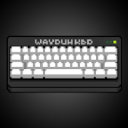Keyboard Builders' Digest /
PCB design, stonework, and combining them together
WayduhKBD sums up the year including learning PCB design and combining two hobbies.
Published December 12, 2023

My name is Wade, but I go by WayduhKBD on most platforms. I am fairly new to the hobby overall but have enjoyed getting into it!
I started getting into mechanical keyboards in late 2021, primarily 60% keyboards. The main use for my setup is gaming. I wanted to free up desk space and decided to move towards smaller boards.
At that point, I also wanted something a bit more unique than store-bought boards. I was drawn to the exposed components of the Gingham, a through-hole 60% by Yiancar. That build really opened my eyes to the keyboard hobby. With a better idea of options, I then wanted to add some more to my setup.
I had easy access to stone but hadn’t worked with it before. I eventually landed on the idea of making wrist rests – I feel they add more to a setup beyond functionality.
The primary material I work with is marble, mostly 1/4” thick. These normally need feet or cork to adjust to board height. I do experiment with some thicker marble, as well, but it can be a bit more difficult to work with.
I’m not currently producing wrist rests, instead focusing on learning about other possible avenues with stonework. I would love to make wrist rests with engravings or designs done by hand, and might explore adding wood or other materials.
My favorite part of making wrist rests is seeing them in the wild. They’re fairly basic, but can add a cool touch to somebody’s setup. And lot of hobbyists enjoy taking photos of their setups, so it helps in that regard, as well!
I have a few friends in the hobby who are very talented at designing PCBs, cases, etc. This made me interested to learn for myself. Thankfully, there are a lot of great, free resources online (including this website). The main guide I’ve used for PCB design is a set of videos from Kiser Designs. Having a video to follow is a huge benefit for visual learners, such as myself.
Both designs I started with are plateless. Plates are handy for alignment, but I chose to skip that. I personally love the look of plateless, as it provides a bit of the exposed component feeling I like in a board.
My first PCB design, 3uGoood, is based on my most used board, a 5x10u ortholinear design called the Littlefoot. I wanted to follow the compact feel of that design, and the name 3uGoood comes from the single layout option: ortholinear and split 3u space bars. I liked this route for its straightforward character. Sometimes people just want a single layout and don’t want to mess with anything else – just order the PCB, get some switches, and you’re golden!
I plan to open source 3uGoood, once I make a couple of adjustments.
Following that design, I started to experiment with increasing the distance between my hands. I used Littlefoot as reference on this, as well, focusing on shoulder posture and placing my hands in an area that felt comfortable. The result of that work was another straightforward design called Orthofly. This board is the same layout option as 3uGoood but with different spacing. The distance between hands is 3u wide, and the bottom row has a 0.25u offset for the bottom set of buttons.
This new setup gave me the shoulder posture I was looking for, and the dropped bottom row has helped a ton with thumb placement. I plan to go through my other boards for more inspiration.
The next design I plan on finishing is called CrystalBall. Growing up we would go out and dig for crystals with my dad. I wanted to style a board around that, as we still do it occasionally. Besides crystals, I enjoy most stone types like quartz, fluorite, obsidian, etc.
This board is a similar layout to Orthofly, but with a 20 mm hole in the center. The board will be plateless and top-mount, with mounting points on each narrow end. I also plan to have lighting on the underside of the board, with the middle hole backed by a slice of clear quartz that will serve as a diffuser.
I plan on integrating stone into more keyboard items in the future, such as cases and weights. Cases will be challenging and will require more precise machinery, given stone’s propensity for chipping and cracks. Stone weights should also be simpler to incorporate into case designs. I think the natural variations in stone will contribute a uniqueness that many hobbyists find appealing.
The first hurdle to overcome is acquiring the right tools, but then it’ll just be a matter of discovering the right processes to overcome any inherent challenges.
WayduhKBD | |
| Handle | @wayduhKBD |
| Location | Nevada, USA |
| Joined | 2021 |
| Niche | stone |
| Fav. switch | JWICK Black |
| Fav. keycap profile | DSS |
| Other hobbies | stonework, rockhounding, knives, audio, and gaming |
| Links | Liktree |
Published on Tue 12th Dec 2023. Featured in KBD #2023.












